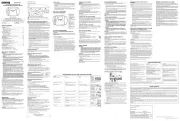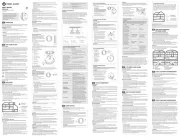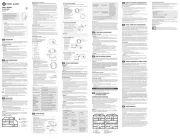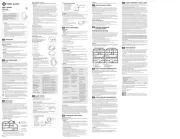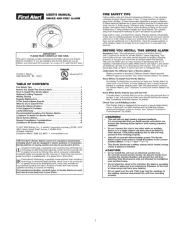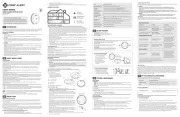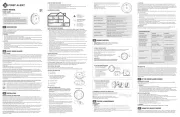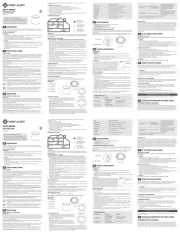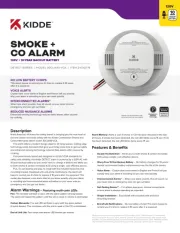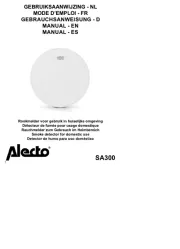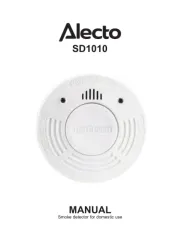
IMPORTANT! PLEASE READ CAREFULLY AND SAVE.
The warnings/limitations card and manual contains important information
about your Smoke Alarm’s operation. If you are installing this Alarm for use
by others, you must leave this manual—or a copy of it—with the end user.
Para el manual del usuario en español, por favor visite rstalert.com
Thank you for choosing First Alert
for your Smoke Alarm needs. You have purchased a state-of-the-art Smoke Alarm
designed to provide you with early warning of a re. Please take the time to read this manual and make the Smoke Alarm
an integral part of your family’s safety plan.
• This unit will not alert hearing impaired residents. It is recommended that you install special units which use devices
like ashing strobe lights to alert hearing impaired residents.
• Do not connect this unit to any other Alarm or auxiliary device. It is a single-station unit that cannot be linked to other
devices. Connecting anything else to this unit may prevent it from working properly.
• Unit will not operate without battery power. The Smoke Alarm will not work until activated.
• Do not install this unit over an electrical junction box. Air currents around junction boxes can prevent smoke from
reaching the sensing chamber and prevent the unit from Alarming. Only AC powered units are intended for installation
• Do not stand too close to the unit when the Alarm is sounding. It is loud to wake you in an emergency. Exposure to the
horn at close range may harm your hearing.
• Do not paint over the unit. Paint may clog the openings to the sensing chamber and prevent the unit from
All these Smoke Alarms are designed to provide early warning of res if located, installed and cared for as described in
the user’s manual, and if smoke reaches the Alarm. If you are unsure which type of unit to install, refer to NFPA (National
Fire Protection Association) 72 (National Fire Alarm and Signaling Code) and NFPA 101 (Life Safety Code). National Fire
Protection Association, One Batterymarch Park, Quincy, MA 02269-9101. Local building codes may also require specic
units in new construction or in different areas of the home.
Battery (DC) operated Smoke Alarms: Provide protection even when electricity fails, provided the batteries are fresh
and correctly installed. Units are easy to install, and do not require professional installation. They do not, however, provide
interconnected functionality.
AC powered Smoke Alarms: Can be interconnected so if one unit senses smoke, all units Alarm. They do not operate if
AC with battery (DC) back-up: will operate if electricity fails, provided the batteries are fresh and correctly installed. AC
and AC/DC units must be installed by a qualied electrician.
Smoke Alarms for Solar or wind energy users and battery backup power systems: AC powered Smoke Alarms
should only be operated with true or pure sine wave inverters. Operating this Smoke Alarm with most battery powered
UPS (uninterruptible power supply) products or square wave or “quasi sine wave” inverters . If will damage the Alarm
you are not sure about your inverter or UPS type, please consult with the manufacturer to verify.
Smoke Alarms for the hearing impaired: Special purpose Smoke Alarms should be installed for the hearing impaired.
They include a visual Alarm and an audible Alarm horn, and meet the requirements of the Americans with Disabilities Act.
These units can be interconnected so if one unit senses smoke, all units Alarm.
Smoke Alarms are not to be used with detector guards unless the combination has been evaluated and found suitable
Smoke Alarms conform to regulatory requirements, including UL217 and are designed to detect
particles of combustion. Smoke particles of varying number and size are produced in all res.
Ionization technology is generally more sensitive than photoelectric technology at detecting small particles,
which tend to be produced in greater amounts by aming res, which consume combustible materials rapidly
and spread quickly. Sources of these res may include paper burning in a wastebasket, or a grease re
Photoelectric technology is generally more sensitive than ionization technology at detecting large particles,
which tend to be produced in greater amounts by smoldering res, which may smolder for hours before
bursting into ame. Sources of these res may include cigarettes burning in couches or bedding.
For maximum protection, use both types of Smoke Alarms on each level and in every bedroom of your home.
BEFORE YOU INSTALL THIS SMOKE ALARM
Read “Recommended Locations for Smoke Alarms” and “Locations to Avoid for Smoke Alarms” before beginning. This
unit monitors the air, and when smoke reaches its sensing chamber, it Alarms. It can give you more time to escape before
re spreads. This unit can ONLY give an early warning of developing res if it is installed, maintained and located where
smoke can reach it, and where all residents can hear it, as described in this manual. This unit will not sense gas, heat, or
ame. It cannot prevent or extinguish res.
Understand The Different Type of Smoke Alarms: Battery powered or electrical? Different Smoke Alarms provide
different types of protection. See “About Smoke Alarms” for details.
Know Where To Install Your Smoke Alarms: Fire Safety Professionals recommend at least one Smoke Alarm on every
level of your home, in every bedroom, and in every bedroom hallway or separate sleeping area. See “Recommended
Locations for Smoke Alarms” and “Locations to Avoid for Smoke Alarms” for details.
Know What Smoke Alarms Can and Can’t Do: A Smoke Alarm can help alert you to re, giving you precious time to
escape. It can only sound an Alarm once smoke reaches the sensor. See “Limitations of Smoke Alarms” for details.
Check Your Local Building Codes: This Smoke Alarm is designed to be used in a typical single family home. It alone
will not meet requirements for boarding houses, apartment buildings, hotels or motels. See “Special Compliance
Considerations” for details.
IN GENERAL, INSTALL SMOKE ALARMS:
• On every level of your home, including nished attics and basements.
• Inside every bedroom, especially if people sleep with the door partly or completely closed.
• In the hall near every sleeping area. If your home has multiple sleeping areas, install a unit in each.
• If a hall is more than 40 feet (12 meters) long, install a unit at each end.
• At the top of rst-to-second oor stairs.
• At the bottom of the basement stairs.
• For additional coverage, install Alarms in all rooms, halls, and storage areas, where temperatures normally remain
between 40˚ F and 100˚ F (4.4˚ C and 37.8˚ C).
Specic requirements for Smoke Alarm installation vary from state to state and from region to region. Check with your
local Fire Department for current requirements in your area. It is recommended AC or AC/DC units be interconnected
WHERE NOT TO INSTALL THIS ALARM
FOR BEST PERFORMANCE, IT IS RECOMMENDED YOU AVOID INSTALLING SMOKE ALARMS IN THESE AREAS:
• Where combustion particles are produced. Combustion particles form when something burns. Areas to avoid include
poorly ventilated kitchens, garages, and furnace rooms. Keep units at least 20 feet (6 meters) from the sources of
combustion particles (stove, furnace, water heater, space heater) if possible. In areas where a 20-foot (6-meter)
distance is not possible – in modular, mobile, or smaller homes, for example – it is recommended the Smoke
Alarm be placed as far from these fuel-burning sources as possible. The placement recommendations are intended
to keep these Alarms at a reasonable distance from a fuel-burning source, and thus reduce “unwanted” Alarms.
Unwanted Alarms can occur if a Smoke Alarm is placed directly next to a fuel-burning source. Ventilate these areas
• In air streams near kitchens. Air currents can draw cooking smoke into the sensing chamber of a Smoke Alarm
• In very damp, humid or steamy areas, or directly near bathrooms with showers. Keep units at least 10 feet (3 meters)
away from showers, saunas, dishwashers, etc.
• Where the temperatures are regularly below 40˚ F (4.4˚ C) or above 100˚ F (37.8˚ C), including unheated buildings,
outdoor rooms, porches, or unnished attics or basements.
• In very dusty, dirty, or greasy areas. Do not install a Smoke Alarm directly over the stove or range. Keep laundry room
Smoke Alarms free of dust or lint.
• Near fresh air vents, ceiling fans, or in very drafty areas. Drafts can blow smoke away from the unit, preventing it
from reaching the sensing chamber.
• In insect infested areas. Insects can clog openings to the sensing chamber and cause unwanted Alarms.
• Less than 12 inches (305mm) away from uorescent lights. Electrical “noise” can interfere with the sensor.
• In “dead air” spaces. “Dead air” spaces may prevent smoke from reaching the Smoke Alarm.
“Dead air” spaces may prevent smoke from reaching the Smoke Alarm. To avoid dead air spaces, follow the installation
On ceilings, install Smoke Alarms as close to the center of the ceiling as possible. If this is not possible, install the Smoke
Alarm at least 4 inches (102 mm) from the wall or corner.
For wall mounting (if allowed by building codes), the top edge of Smoke Alarms should be placed between 4 inches (102
mm) and 12 inches (305 mm) from the wall/ceiling line, below typical “dead air” spaces.
On a peaked, gabled, or cathedral ceiling, install the rst Smoke Alarm within 3 feet (0.9 meters) of the peak of the
ceiling, measured horizontally. Additional Smoke Alarms may be required depending on the length, angle, etc. of the
ceiling’s slope. Refer to NFPA 72 for details on requirements for sloped or peaked ceilings.
HOW TO INSTALL THIS ALARM
This unit is designed to be mounted on the ceiling, or on the wall if necessary.
Tools you will need: pencil, drill with 3/16" (5 mm) drill bit, standard Phillips head screwdriver, hammer.
FOLLOW THESE SIMPLE STEPS
1. Attach the mounting bracket to the wall or ceiling as follows: Use the two xing
slots on the mounting ring as a guide when marking the position of the drill
holes. With an appropriately sized drill, drill the holes and insert the plastic xing
anchors supplied (if needed). See diagram.
NOTE: Do not remove labels from the Alarm.
2. Install Mounting Bracket: Fit the mounting bracket to the ceiling or wall
using the screws provided. Ensure that the screw heads are ush. Insert the
plastic screw anchors (in the plastic bag with screws) into the holes. Tap the
screw anchors gently with a hammer, if necessary, until they are ush with the
3. Activate Your Smoke Alarm: Position the Smoke Alarm over the mounting bracket and turn clockwise. You should
feel the Alarm click into place. The Alarm will self-activate once mounted. To ensure Alarm is activated, press and
hold the test button. During testing you will hear a loud, repeating horn pattern: 3 beeps, pause, 3 beeps, pause. If the
unit does not Alarm during testing, call consumer affairs for assistance. The LED will ash approximately every NOTE:
six minutes under normal operation. Test Your Smoke Alarm. See “Weekly Testing.”
Action What You Will See & Hear
Normal Operation Red LED ash every 6 minutes. No audible Alarm.
Test Condition Rapidly ashing red LED. Audible Alarm.
Alarm Condition Rapidly ashing red LED. Audible Alarm.
Silence Mode Red LED ash every 10 seconds. No audible Alarm.
Low Battery 1 chirp every 43 seconds.
End of Life 5 chirps approximately every 43 seconds.
Malfunction 3 chirps every 43 seconds.
• : Small but mighty, same protection as a regular sized Alarm.Micro Design
• For the life of the Alarm.No Battery Replacements:
• Add protection in minutes.Easy Installation:
• Let’s you know when it’s time to replace. End-Of-Life Warning:
TO PERMANENTLY DEACTIVATE THE SMOKE ALARM
After 10 years of operation or Low Battery/End of Life Warnings, deactivate the Alarm: Insert a Phillips head screwdriver
into the space shown. Turn 90° clockwise a quarter turn until you hear a click. Once you hear the click, the device will be
NOTE: At end of life or low battery indication (chirp): unit must be put into deactivation mode to deactivate remaining
stored energy in battery. Unit will no longer function once put into this mode. Unit will resist re-mounting.
• use an open ame of any kind to test this unit. You might accidentally damage or set re to the unit NEVER
• If the Alarm ever fails to test properly, replace it immediately. Products under warranty may be returned to the
manufacturer for replacement. See “Limited Warranty” for details.
• stand close to the Alarm when the horn is sounding. Exposure at close range may be harmful to your hearing. DO NOT
When testing, step away when horn starts sounding.
It is important to test this unit every week to make sure it is working properly.
Using the Test/Silence button is the recommended way to test this Smoke Alarm.
Press and hold the Test/Silence button on the cover of the unit until the Alarm
sounds (the unit may continue to Alarm for a few seconds after you release the
button). If it does not Alarm, make sure the unit is receiving power and test it
again. If it still does not Alarm, replace it immediately. During testing, you will
hear an audible Alarm and see a rapidly ashing red LED. If you hear 6 or more
chirps before the audible Alarm and ashing red LED, this means your Alarm
detected smoke in the last 24 hours or so. You will only hear this indicator once.
This unit has been designed to be as maintenance free as possible, but there are a few simple things you must do to
keep it working properly.
• Test it at least once a week.
• Clean the Smoke Alarm at least once a month; gently vacuum off any dust using your household vacuum’s soft
brush attachment, and test the Smoke Alarm after cleaning. Never use water, cleaners or solvents since they may
• If the Smoke Alarm becomes contaminated by excessive dirt, dust and/or grime, and cannot be cleaned to avoid
unwanted Alarms, replace the unit immediately.
• If the green power LED ashes 2 times every minute (horn is silent) it means that the Alarm needs to be cleaned as
indicated above. If red light continues to ash, replace Alarm.
• Relocate the unit if it sounds frequent unwanted Alarms. See “Locations to Avoid for Smoke Alarms” for details.
• When the battery becomes weak, the Smoke Alarm unit will “chirp” approximately once a minute (the Low Battery
Warning). This Low Battery Warning should last for up to 30 days, but you should replace the Smoke Alarm
immediately to continue your protection.
• Protect or cover the alarm when doing any maintenance to home i.e. sanding oors, painting, drywall patching, etc.
to prevent contamination.
Actual service life depends on the Smoke Alarm and the environment in which it is installed. You replace the MUST
Smoke Alarm immediately once the unit starts “chirping” (the “Low Battery Warning”).
IF THE ALARM... PROBLEM… YOU SHOULD...
If unit is under warranty, contact
Consumer Support to process a
Alarm needs to be replaced.
Immediately replace the Alarm.
Smoke Alarm sounds when no
source like cooking smoke.
Silence Alarm using manual button; clean
the Alarm’s cover with a soft, clean cloth.
If frequent unwanted Alarms continue,
relocate your Alarm. Alarm may be too
close to a kitchen, cooking appliance, or
Clean Alarm then press and release the test
button. See Regular Maintenance section.
If Green LED Continues to ash, contact
If you have questions that cannot be answered by reading this manual, call the
Consumer Support Team at 1-800-323-9005.
Follow safety rules and prevent hazardous situations: 1) Use smoking materials properly. Never smoke in bed. 2) Keep
matches or lighters away from children; 3) Store ammable materials in proper containers; 4) Keep electrical appliances
in good condition and don’t overload electrical circuits; 5) Keep stoves, barbecue grills, replaces and chimneys grease-
and debris-free; 6) Never leave anything cooking on the stove unattended; 7) Keep portable heaters and open ames,
like candles, away from ammable materials; 8) Don’t let rubbish accumulate. Keep Alarms clean, and test them weekly.
Replace Alarms immediately if they are not working properly. Smoke Alarms that do not work cannot alert you to a
re. Keep at least one working re extinguisher on every level, and an additional one in the kitchen. Have re escape
ladders or other reliable means of escape from an upper level in case stairs are blocked; 9) Have an escape plan and
IF THIS SMOKE ALARM SOUNDS
During an Alarm, you will hear a loud, repeating horn pattern: 3 beeps, pause, 3 beeps, pause. The Red LED
• If the unit Alarms get everyone out of the house immediately.
• If the unit Alarms and you are not testing the unit, it is warning you of a potentially dangerous situation that requires
your immediate attention. ignore any Alarm. Ignoring the Alarm may result in injury or death.NEVER
• Never remove the batteries from a battery operated Smoke Alarm to stop an unwanted Alarm (caused by cooking
smoke, etc.). Removing batteries disables the Alarm so it cannot sense smoke, and removes your protection. Instead
open a window or fan the smoke away from the unit. The Alarm will reset automatically.
WHAT TO DO IN CASE OF FIRE
• Don’t panic; stay calm. Follow your family escape plan.
• Get out of the house as quickly as possible. Don’t stop to get dressed or collect anything.
• Feel doors with the back of your hand before opening them. If a door is cool, open it slowly. Don’t open a hot door.
Keep doors and windows closed, unless you must escape through them.
• Cover your nose and mouth with a cloth (preferably damp). Take short, shallow breaths.
• Meet at your planned meeting place outside your home, and do a head count to make sure everybody got out safely.
• Call the Fire Department as soon as possible from outside. Give your address, then your name.
• Never go back inside a burning building for any reason.
• Contact your Fire Department for ideas on making your home safer.
Alarms have various limitations. See “General Limitations of Smoke Alarms” for details.
USING THE SILENCE FEATURE
The Silence Feature can temporarily quiet an unwanted Alarm for up to 9 minutes. To use this feature, press the Test/
Silence button on the cover. If the unit will not silence and no heavy smoke is present, or if it stays in silence mode
continuously, it should be replaced immediately. The LED will ash every 10 seconds while in silence.
The Silence Feature does not disable the unit—it makes it temporarily less sensitive to smoke. For your safety, if
smoke around the unit is dense enough to suggest a potentially dangerous situation, the unit will stay in Alarm or
may re-Alarm quickly. If you do not know the source of the smoke, do not assume it is an unwanted Alarm. Not
responding to an Alarm can result in property loss, injury, or death.
SILENCING THE LOW BATTERY WARNING
This Silence Feature can temporarily quiet the Low Battery Warning “chirp”. Press the Test/Silence button on the Alarm.
The Red light ashes normally, once every 6 minutes, during Low Battery Warning silence. After time, the low battery
“chirp” will resume. Deactivate the Smoke Alarm and replace it immediately.
Smoke Alarms may not operate properly because of a dead or weak battery, a build-up of dirt, dust or grease on
the Smoke Alarm cover, or installation in an improper location. Clean the Smoke Alarm as described in “Regular
Maintenance,” and then test the Smoke Alarm again. If it fails to test properly when you use the test button, or if the
problem persists, replace the Smoke Alarm immediately.
• If you hear a “chirp” about once a minute, replace the Smoke Alarm.
• If you experience frequent non-emergency Alarms (like those caused by cooking smoke), try relocating
• If the Alarm sounds when no smoke is visible, try cleaning or relocating the Smoke Alarm. The cover may be dirty.
Do not try xing the Alarm yourself — this will void your warranty!
If the Smoke Alarm is still not operating properly, and it is still under warranty, please see “How to Obtain Warranty
Service” in the Limited Warranty.
REGULATORY INFORMATION FOR SMOKE ALARMS
RECOMMENDED LOCATIONS FOR SMOKE ALARMS
INSTALLING SMOKE ALARMS IN SINGLE-FAMILY RESIDENCES
The National Fire Protection Association (NFPA), recommends one Smoke Alarm on every level, in every sleeping area,
and in every bedroom. In new construction, the Smoke Alarms must be AC powered and interconnected. See “Agency
Placement Recommendations” for details. For additional coverage, it is recommended that you install a Smoke Alarm in
all rooms, halls, storage areas, nished attics, and basements, where temperatures normally remain between 40˚ F (4.4˚
C) and 100˚ F (37.8˚ C). Make sure no door or other obstruction could keep smoke from reaching the Smoke Alarms.
IMPORTANT! PLEASE READ CAREFULLY AND SAVE.
The warnings/limitations card and manual contains important information
about your Smoke Alarm’s operation. If you are installing this Alarm for use
by others, you must leave this manual—or a copy of it—with the end user.
Para el manual del usuario en español, por favor visite rstalert.com
Thank you for choosing First Alert
for your Smoke Alarm needs. You have purchased a state-of-the-art Smoke Alarm
designed to provide you with early warning of a re. Please take the time to read this manual and make the Smoke Alarm
an integral part of your family’s safety plan.
• This unit will not alert hearing impaired residents. It is recommended that you install special units which use devices
like ashing strobe lights to alert hearing impaired residents.
• Do not connect this unit to any other Alarm or auxiliary device. It is a single-station unit that cannot be linked to other
devices. Connecting anything else to this unit may prevent it from working properly.
• Unit will not operate without battery power. The Smoke Alarm will not work until activated.
• Do not install this unit over an electrical junction box. Air currents around junction boxes can prevent smoke from
reaching the sensing chamber and prevent the unit from Alarming. Only AC powered units are intended for installation
• Do not stand too close to the unit when the Alarm is sounding. It is loud to wake you in an emergency. Exposure to the
horn at close range may harm your hearing.
• Do not paint over the unit. Paint may clog the openings to the sensing chamber and prevent the unit from
All these Smoke Alarms are designed to provide early warning of res if located, installed and cared for as described in
the user’s manual, and if smoke reaches the Alarm. If you are unsure which type of unit to install, refer to NFPA (National
Fire Protection Association) 72 (National Fire Alarm and Signaling Code) and NFPA 101 (Life Safety Code). National Fire
Protection Association, One Batterymarch Park, Quincy, MA 02269-9101. Local building codes may also require specic
units in new construction or in different areas of the home.
Battery (DC) operated Smoke Alarms: Provide protection even when electricity fails, provided the batteries are fresh
and correctly installed. Units are easy to install, and do not require professional installation. They do not, however, provide
interconnected functionality.
AC powered Smoke Alarms: Can be interconnected so if one unit senses smoke, all units Alarm. They do not operate if
AC with battery (DC) back-up: will operate if electricity fails, provided the batteries are fresh and correctly installed. AC
and AC/DC units must be installed by a qualied electrician.
Smoke Alarms for Solar or wind energy users and battery backup power systems: AC powered Smoke Alarms
should only be operated with true or pure sine wave inverters. Operating this Smoke Alarm with most battery powered
UPS (uninterruptible power supply) products or square wave or “quasi sine wave” inverters . If will damage the Alarm
you are not sure about your inverter or UPS type, please consult with the manufacturer to verify.
Smoke Alarms for the hearing impaired: Special purpose Smoke Alarms should be installed for the hearing impaired.
They include a visual Alarm and an audible Alarm horn, and meet the requirements of the Americans with Disabilities Act.
These units can be interconnected so if one unit senses smoke, all units Alarm.
Smoke Alarms are not to be used with detector guards unless the combination has been evaluated and found suitable
Smoke Alarms conform to regulatory requirements, including UL217 and are designed to detect
particles of combustion. Smoke particles of varying number and size are produced in all res.
Ionization technology is generally more sensitive than photoelectric technology at detecting small particles,
which tend to be produced in greater amounts by aming res, which consume combustible materials rapidly
and spread quickly. Sources of these res may include paper burning in a wastebasket, or a grease re
Photoelectric technology is generally more sensitive than ionization technology at detecting large particles,
which tend to be produced in greater amounts by smoldering res, which may smolder for hours before
bursting into ame. Sources of these res may include cigarettes burning in couches or bedding.
For maximum protection, use both types of Smoke Alarms on each level and in every bedroom of your home.
BEFORE YOU INSTALL THIS SMOKE ALARM
Read “Recommended Locations for Smoke Alarms” and “Locations to Avoid for Smoke Alarms” before beginning. This
unit monitors the air, and when smoke reaches its sensing chamber, it Alarms. It can give you more time to escape before
re spreads. This unit can ONLY give an early warning of developing res if it is installed, maintained and located where
smoke can reach it, and where all residents can hear it, as described in this manual. This unit will not sense gas, heat, or
ame. It cannot prevent or extinguish res.
Understand The Different Type of Smoke Alarms: Battery powered or electrical? Different Smoke Alarms provide
different types of protection. See “About Smoke Alarms” for details.
Know Where To Install Your Smoke Alarms: Fire Safety Professionals recommend at least one Smoke Alarm on every
level of your home, in every bedroom, and in every bedroom hallway or separate sleeping area. See “Recommended
Locations for Smoke Alarms” and “Locations to Avoid for Smoke Alarms” for details.
Know What Smoke Alarms Can and Can’t Do: A Smoke Alarm can help alert you to re, giving you precious time to
escape. It can only sound an Alarm once smoke reaches the sensor. See “Limitations of Smoke Alarms” for details.
Check Your Local Building Codes: This Smoke Alarm is designed to be used in a typical single family home. It alone
will not meet requirements for boarding houses, apartment buildings, hotels or motels. See “Special Compliance
Considerations” for details.
IN GENERAL, INSTALL SMOKE ALARMS:
• On every level of your home, including nished attics and basements.
• Inside every bedroom, especially if people sleep with the door partly or completely closed.
• In the hall near every sleeping area. If your home has multiple sleeping areas, install a unit in each.
• If a hall is more than 40 feet (12 meters) long, install a unit at each end.
• At the top of rst-to-second oor stairs.
• At the bottom of the basement stairs.
• For additional coverage, install Alarms in all rooms, halls, and storage areas, where temperatures normally remain
between 40˚ F and 100˚ F (4.4˚ C and 37.8˚ C).
Specic requirements for Smoke Alarm installation vary from state to state and from region to region. Check with your
local Fire Department for current requirements in your area. It is recommended AC or AC/DC units be interconnected
WHERE NOT TO INSTALL THIS ALARM
FOR BEST PERFORMANCE, IT IS RECOMMENDED YOU AVOID INSTALLING SMOKE ALARMS IN THESE AREAS:
• Where combustion particles are produced. Combustion particles form when something burns. Areas to avoid include
poorly ventilated kitchens, garages, and furnace rooms. Keep units at least 20 feet (6 meters) from the sources of
combustion particles (stove, furnace, water heater, space heater) if possible. In areas where a 20-foot (6-meter)
distance is not possible – in modular, mobile, or smaller homes, for example – it is recommended the Smoke
Alarm be placed as far from these fuel-burning sources as possible. The placement recommendations are intended
to keep these Alarms at a reasonable distance from a fuel-burning source, and thus reduce “unwanted” Alarms.
Unwanted Alarms can occur if a Smoke Alarm is placed directly next to a fuel-burning source. Ventilate these areas
• In air streams near kitchens. Air currents can draw cooking smoke into the sensing chamber of a Smoke Alarm
• In very damp, humid or steamy areas, or directly near bathrooms with showers. Keep units at least 10 feet (3 meters)
away from showers, saunas, dishwashers, etc.
• Where the temperatures are regularly below 40˚ F (4.4˚ C) or above 100˚ F (37.8˚ C), including unheated buildings,
outdoor rooms, porches, or unnished attics or basements.
• In very dusty, dirty, or greasy areas. Do not install a Smoke Alarm directly over the stove or range. Keep laundry room
Smoke Alarms free of dust or lint.
• Near fresh air vents, ceiling fans, or in very drafty areas. Drafts can blow smoke away from the unit, preventing it
from reaching the sensing chamber.
• In insect infested areas. Insects can clog openings to the sensing chamber and cause unwanted Alarms.
• Less than 12 inches (305mm) away from uorescent lights. Electrical “noise” can interfere with the sensor.
• In “dead air” spaces. “Dead air” spaces may prevent smoke from reaching the Smoke Alarm.
“Dead air” spaces may prevent smoke from reaching the Smoke Alarm. To avoid dead air spaces, follow the installation
On ceilings, install Smoke Alarms as close to the center of the ceiling as possible. If this is not possible, install the Smoke
Alarm at least 4 inches (102 mm) from the wall or corner.
For wall mounting (if allowed by building codes), the top edge of Smoke Alarms should be placed between 4 inches (102
mm) and 12 inches (305 mm) from the wall/ceiling line, below typical “dead air” spaces.
On a peaked, gabled, or cathedral ceiling, install the rst Smoke Alarm within 3 feet (0.9 meters) of the peak of the
ceiling, measured horizontally. Additional Smoke Alarms may be required depending on the length, angle, etc. of the
ceiling’s slope. Refer to NFPA 72 for details on requirements for sloped or peaked ceilings.
HOW TO INSTALL THIS ALARM
This unit is designed to be mounted on the ceiling, or on the wall if necessary.
Tools you will need: pencil, drill with 3/16" (5 mm) drill bit, standard Phillips head screwdriver, hammer.
FOLLOW THESE SIMPLE STEPS
1. Attach the mounting bracket to the wall or ceiling as follows: Use the two xing
slots on the mounting ring as a guide when marking the position of the drill
holes. With an appropriately sized drill, drill the holes and insert the plastic xing
anchors supplied (if needed). See diagram.
NOTE: Do not remove labels from the Alarm.
2. Install Mounting Bracket: Fit the mounting bracket to the ceiling or wall
using the screws provided. Ensure that the screw heads are ush. Insert the
plastic screw anchors (in the plastic bag with screws) into the holes. Tap the
screw anchors gently with a hammer, if necessary, until they are ush with the
3. Activate Your Smoke Alarm: Position the Smoke Alarm over the mounting bracket and turn clockwise. You should
feel the Alarm click into place. The Alarm will self-activate once mounted. To ensure Alarm is activated, press and
hold the test button. During testing you will hear a loud, repeating horn pattern: 3 beeps, pause, 3 beeps, pause. If the
unit does not Alarm during testing, call consumer affairs for assistance. The LED will ash approximately every NOTE:
six minutes under normal operation. Test Your Smoke Alarm. See “Weekly Testing.”
Action What You Will See & Hear
Normal Operation Red LED ash every 6 minutes. No audible Alarm.
Test Condition Rapidly ashing red LED. Audible Alarm.
Alarm Condition Rapidly ashing red LED. Audible Alarm.
Silence Mode Red LED ash every 10 seconds. No audible Alarm.
Low Battery 1 chirp every 43 seconds.
End of Life 5 chirps approximately every 43 seconds.
Malfunction 3 chirps every 43 seconds.
• : Small but mighty, same protection as a regular sized Alarm.Micro Design
• For the life of the Alarm.No Battery Replacements:
• Add protection in minutes.Easy Installation:
• Let’s you know when it’s time to replace. End-Of-Life Warning:
TO PERMANENTLY DEACTIVATE THE SMOKE ALARM
After 10 years of operation or Low Battery/End of Life Warnings, deactivate the Alarm: Insert a Phillips head screwdriver
into the space shown. Turn 90° clockwise a quarter turn until you hear a click. Once you hear the click, the device will be
NOTE: At end of life or low battery indication (chirp): unit must be put into deactivation mode to deactivate remaining
stored energy in battery. Unit will no longer function once put into this mode. Unit will resist re-mounting.
• use an open ame of any kind to test this unit. You might accidentally damage or set re to the unit NEVER
• If the Alarm ever fails to test properly, replace it immediately. Products under warranty may be returned to the
manufacturer for replacement. See “Limited Warranty” for details.
• stand close to the Alarm when the horn is sounding. Exposure at close range may be harmful to your hearing. DO NOT
When testing, step away when horn starts sounding.
It is important to test this unit every week to make sure it is working properly.
Using the Test/Silence button is the recommended way to test this Smoke Alarm.
Press and hold the Test/Silence button on the cover of the unit until the Alarm
sounds (the unit may continue to Alarm for a few seconds after you release the
button). If it does not Alarm, make sure the unit is receiving power and test it
again. If it still does not Alarm, replace it immediately. During testing, you will
hear an audible Alarm and see a rapidly ashing red LED. If you hear 6 or more
chirps before the audible Alarm and ashing red LED, this means your Alarm
detected smoke in the last 24 hours or so. You will only hear this indicator once.
This unit has been designed to be as maintenance free as possible, but there are a few simple things you must do to
keep it working properly.
• Test it at least once a week.
• Clean the Smoke Alarm at least once a month; gently vacuum off any dust using your household vacuum’s soft
brush attachment, and test the Smoke Alarm after cleaning. Never use water, cleaners or solvents since they may
• If the Smoke Alarm becomes contaminated by excessive dirt, dust and/or grime, and cannot be cleaned to avoid
unwanted Alarms, replace the unit immediately.
• If the green power LED ashes 2 times every minute (horn is silent) it means that the Alarm needs to be cleaned as
indicated above. If red light continues to ash, replace Alarm.
• Relocate the unit if it sounds frequent unwanted Alarms. See “Locations to Avoid for Smoke Alarms” for details.
• When the battery becomes weak, the Smoke Alarm unit will “chirp” approximately once a minute (the Low Battery
Warning). This Low Battery Warning should last for up to 30 days, but you should replace the Smoke Alarm
immediately to continue your protection.
• Protect or cover the alarm when doing any maintenance to home i.e. sanding oors, painting, drywall patching, etc.
to prevent contamination.
Actual service life depends on the Smoke Alarm and the environment in which it is installed. You replace the MUST
Smoke Alarm immediately once the unit starts “chirping” (the “Low Battery Warning”).
IF THE ALARM... PROBLEM… YOU SHOULD...
If unit is under warranty, contact
Consumer Support to process a
Alarm needs to be replaced.
Immediately replace the Alarm.
Smoke Alarm sounds when no
source like cooking smoke.
Silence Alarm using manual button; clean
the Alarm’s cover with a soft, clean cloth.
If frequent unwanted Alarms continue,
relocate your Alarm. Alarm may be too
close to a kitchen, cooking appliance, or
Clean Alarm then press and release the test
button. See Regular Maintenance section.
If Green LED Continues to ash, contact
If you have questions that cannot be answered by reading this manual, call the
Consumer Support Team at 1-800-323-9005.
Follow safety rules and prevent hazardous situations: 1) Use smoking materials properly. Never smoke in bed. 2) Keep
matches or lighters away from children; 3) Store ammable materials in proper containers; 4) Keep electrical appliances
in good condition and don’t overload electrical circuits; 5) Keep stoves, barbecue grills, replaces and chimneys grease-
and debris-free; 6) Never leave anything cooking on the stove unattended; 7) Keep portable heaters and open ames,
like candles, away from ammable materials; 8) Don’t let rubbish accumulate. Keep Alarms clean, and test them weekly.
Replace Alarms immediately if they are not working properly. Smoke Alarms that do not work cannot alert you to a
re. Keep at least one working re extinguisher on every level, and an additional one in the kitchen. Have re escape
ladders or other reliable means of escape from an upper level in case stairs are blocked; 9) Have an escape plan and
IF THIS SMOKE ALARM SOUNDS
During an Alarm, you will hear a loud, repeating horn pattern: 3 beeps, pause, 3 beeps, pause. The Red LED
• If the unit Alarms get everyone out of the house immediately.
• If the unit Alarms and you are not testing the unit, it is warning you of a potentially dangerous situation that requires
your immediate attention. ignore any Alarm. Ignoring the Alarm may result in injury or death.NEVER
• Never remove the batteries from a battery operated Smoke Alarm to stop an unwanted Alarm (caused by cooking
smoke, etc.). Removing batteries disables the Alarm so it cannot sense smoke, and removes your protection. Instead
open a window or fan the smoke away from the unit. The Alarm will reset automatically.
WHAT TO DO IN CASE OF FIRE
• Don’t panic; stay calm. Follow your family escape plan.
• Get out of the house as quickly as possible. Don’t stop to get dressed or collect anything.
• Feel doors with the back of your hand before opening them. If a door is cool, open it slowly. Don’t open a hot door.
Keep doors and windows closed, unless you must escape through them.
• Cover your nose and mouth with a cloth (preferably damp). Take short, shallow breaths.
• Meet at your planned meeting place outside your home, and do a head count to make sure everybody got out safely.
• Call the Fire Department as soon as possible from outside. Give your address, then your name.
• Never go back inside a burning building for any reason.
• Contact your Fire Department for ideas on making your home safer.
Alarms have various limitations. See “General Limitations of Smoke Alarms” for details.
USING THE SILENCE FEATURE
The Silence Feature can temporarily quiet an unwanted Alarm for up to 9 minutes. To use this feature, press the Test/
Silence button on the cover. If the unit will not silence and no heavy smoke is present, or if it stays in silence mode
continuously, it should be replaced immediately. The LED will ash every 10 seconds while in silence.
The Silence Feature does not disable the unit—it makes it temporarily less sensitive to smoke. For your safety, if
smoke around the unit is dense enough to suggest a potentially dangerous situation, the unit will stay in Alarm or
may re-Alarm quickly. If you do not know the source of the smoke, do not assume it is an unwanted Alarm. Not
responding to an Alarm can result in property loss, injury, or death.
SILENCING THE LOW BATTERY WARNING
This Silence Feature can temporarily quiet the Low Battery Warning “chirp”. Press the Test/Silence button on the Alarm.
The Red light ashes normally, once every 6 minutes, during Low Battery Warning silence. After time, the low battery
“chirp” will resume. Deactivate the Smoke Alarm and replace it immediately.
Smoke Alarms may not operate properly because of a dead or weak battery, a build-up of dirt, dust or grease on
the Smoke Alarm cover, or installation in an improper location. Clean the Smoke Alarm as described in “Regular
Maintenance,” and then test the Smoke Alarm again. If it fails to test properly when you use the test button, or if the
problem persists, replace the Smoke Alarm immediately.
• If you hear a “chirp” about once a minute, replace the Smoke Alarm.
• If you experience frequent non-emergency Alarms (like those caused by cooking smoke), try relocating
• If the Alarm sounds when no smoke is visible, try cleaning or relocating the Smoke Alarm. The cover may be dirty.
Do not try xing the Alarm yourself — this will void your warranty!
If the Smoke Alarm is still not operating properly, and it is still under warranty, please see “How to Obtain Warranty
Service” in the Limited Warranty.
REGULATORY INFORMATION FOR SMOKE ALARMS
RECOMMENDED LOCATIONS FOR SMOKE ALARMS
INSTALLING SMOKE ALARMS IN SINGLE-FAMILY RESIDENCES
The National Fire Protection Association (NFPA), recommends one Smoke Alarm on every level, in every sleeping area,
and in every bedroom. In new construction, the Smoke Alarms must be AC powered and interconnected. See “Agency
Placement Recommendations” for details. For additional coverage, it is recommended that you install a Smoke Alarm in
all rooms, halls, storage areas, nished attics, and basements, where temperatures normally remain between 40˚ F (4.4˚
C) and 100˚ F (37.8˚ C). Make sure no door or other obstruction could keep smoke from reaching the Smoke Alarms.
